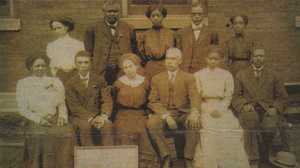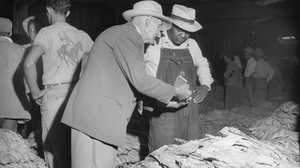Vivien's Baltimore
"We had never visited Baltimore, nor did we know anyone living there... Believing that we didn't have much to lose, that we were young and hopefully had many years ahead, we made the decision to move to Baltimore and to Johns Hopkins," — Vivien Thomas.

In 1941, Vivien Thomas moved to Baltimore, Maryland, a place just as segregated as Nashville, but with its own distinct black culture and community. He had agreed to continue working with Dr. Blalock, who had assumed a department chair at Johns Hopkins University. Although Thomas had a job, he faced the challenge of settling his family in an unfamiliar city.
Explore segregated Baltimore as African Americans experienced it in the mid-twentieth century
Coming to Baltimore:
In Baltimore, Vivien Thomas faced a city that on the surface was very different from Nashville. Baltimore was more urban, with a faster pace and homes packed more tightly together. Like the Thomases, millions of black families arrived from the South and faced drastically different housing and work conditions. Overcrowding sometimes created public health hazards, including a rate of tuberculosis seven times higher than for white neighborhoods.
But like Nashville, Baltimore had a rigid segregation of black and white residents that could surprise new arrivals expecting more tolerance. Blacks were barred from most stores downtown, and they could only live in three neighborhoods. Countee Cullen, a leading voice of the Harlem Renaissance in the 1920s, recorded the painful racism of a Baltimore visit in the poem "Incident."
Black Baltimoreans reacted to this enforced separation by creating their own institutions, and building a strong community with a rich professional and cultural life, despite few resources. "You had everything you needed within a small radius," says historian Phillip Merrill. "You had the housing, the education, the medical... we had it all right there."
"I went to school when I was six years old. Now I have to frankly tell you, as ridiculous as this may sound, that I did not know that I was black, by definition black or colored. I thought I was going to an African American school because my brother, three years older than me, went to that school. So it didn't faze me that there was a difference, it was just that, 'I'm doing what my brother does.' Whenever I went to the movie I went with the maids who took their children that they worked for and they allowed me to come in. So I didn't know there was a difference in that respect. I only found out there was a difference when I reached the age of about eleven years old. When my friends who attended the school that I attended, started visiting me where I lived. I went to the movie one day and when I got there the lady in the ticket box said, 'You can't come in because you're colored.' Well, yeah, colored, what does that really mean in terms of going in? So I went home and I asked my mother, who referred the question to my father. And my father said, 'Well, let me explain it to you this way, Dorothy. You see, in Baltimore there are places that colored people go to and there are places that white people go to. And the places that white people go to, colored people are not allowed to go there," Dorothy Daugherty, Sharp Street Church historian, on her first experience of segregation.
Arts & Culture:
Pennsylvania Avenue was the backbone of West Baltimore. During the daytime, people shopped in many black-owned businesses, or visited the offices of black lawyers and doctors. At night, the avenue glowed with the lights of restaurants, clubs and theaters.
The Royal Theatre was a landmark. On par with Harlem's Apollo Theatre and Washington's Howard, the Royal booked the leading performers of the age. Count Basie, Cab Calloway, Louis Armstrong, Ella Fitzgerald, Duke Ellington, and Billie Holiday all played the Royal. They often could not play other venues in Baltimore because of the city's segregation policy. Such rigid boundaries outside the theater made for a tight bond between artist and audience.
"My first visit to the Royal Theater — which frightened me because of the live band and its sound was so tremendous... I had to sit in the balcony because my mom couldn't get a seat downstairs and traveling up the flight of stairs was frightening... -- they had a special hour at twelve o'clock; I think you could get in for a quarter, which was great. I remember sometimes study periods at the high school and we would all go down and catch a quarter show. I saw everyone, Pearl Bailey... Dinah Washington, Duke Ellington, Doc, Count Basie, oh golly, so many of them... Count Basie was my favorite. In fact he did the last show there, and they closed. The last show there was January the sixth in 1965 and... the last show was Count Basie... the man's hands were like I don't know what on the piano. It was just beautiful, it was great," Delores McIntyre, hospitality director, Senate Club, on the Royal Theater.
Since the 1700s, churches had anchored the city's black community life. Baltimore had the oldest black Catholic church in America. The congregation that started Sharp Street Church dates from 1787; Orchard Street Church was built in 1837 by former slaves; and the St. Francis Academy, Maryland's first Catholic school for African Americans, was founded in 1828. Besides offering a spiritual foundation, the city's black churches were social hubs.
Church and Community Life
It was built to be a magnificent structure. It was the largest church in Baltimore City at that time. It included seating capacity of fifteen hundred people. I can remember very vividly in my mind that I was going to Sharp Street for the Easter sunrise service. You'd have to line up outside about one o'clock to even get a seat here because it was where the Easter pageant was held... and it's the kind of thing that you look forward to because you knew that it was going to be extravagant and you knew that it was going to be excellent...
“The ministers who pastored here weren't just run of the mill, they were men who came with the thought to build, to build the church and to build the community. And how do you build the community? You build the church, you know. You get to each person where they feel their soul is and then you reach out and develop their minds and then their bodies are benefitted, “ Dorothy Daugherty on Sharp Street Church.
Schools formed another cornerstone of community life. Douglass High School was nationally famous for its quality graduates. As in other areas, there was a lot of overlap between student life and church life, and between the church and community activism.
“Some of the schools didn't have large auditoriums so when they had the Christmas plays and Easter plays and programs of that nature a lot of them were held here at the church. Then when you deal with so many other things about African Americans like politics, when there was a drive for someone from the African American community to be elected, that a lot of the political activities were held here. The educational programs were held here,” Dorothy Daugherty on the overlap between school and church life.
Wartime Economy:
In 1942, Baltimore geared for war. The port was mobilized as a key shipbuilding center for the Navy. During World War II, the Bethlehem-Fairfield shipyard alone built nearly four hundred Liberty ships. That created thousands of jobs, many for immigrants and African Americans.
When I first came to Baltimore and my father took me around to Key Highway, I guess you would call that Maryland Shipbuilding or whatever it was, but the ships came right up to -- almost right up to the street. When I saw that, I mean these huge ships, it was fascinating to me. I was awestruck. I mean, I had never seen anything like that before... Things were going on. Everybody was busy, everybody was working, doing something. It was exciting, to say the least, for me. It remained that way for a long time.
I can recall my father when he came up from Virginia he started to work at the shipyard driving rivets. I'm told that that was a tough hot type job with steel rivets into shipbuilding. Somebody in my wife's family that worked at Maryland Dry Dock, worked there for many years. It was hard. I don't know all of the things that they did in repairing and building ships, but it was hard work. But it was one of the places that paid fairly well and you could get a job,” William "Dewey" Parrish, shipyard labor leader, on the wartime shipyards.
"People who had been filling bags with fertilizer suddenly had jobs riveting ships together," says Baltimore journalist Fraser Smith. For thousands of families like the Parrishes, shipyard work was a hot crucible of opportunity.
Enterprise and Self-Sufficiency:
Black Baltimore's economy wasn't fueled solely by the war, by any means. African American businesses grew from within, nurtured from the roots by fraternal societies and social organizations.
Groups like the black Elks, the Prince Hall Masons, and the Social Arch Club formed important networks for growing enterprises during the segregated era. Future Supreme Court justice Thurgood Marshall's family managed a store on the West side for many years.
“Now it was a joy to be a member of the Masonic organization because you're in company with a number of persons who are idealistic, whose principals are lofty and all of that. So it is pleasure being around and a part of them. It also gives you the security of knowing that if you're ever in a jam you got persons who you can call on, not only for yourself but to support your family, whatever the need may be,” Sam Daniels, Grandmaster Emeritus, Prince Hall Masons, on the benefits of being a Mason.
Small businesses here spawned a culture of vending that went out to residents. Baltimore's Arabbers -- men who sold goods from horse-drawn wagons -- continued a tradition begun in the 19th century. Arabbers used unique musical calls to attract customers.
“My grandmother was the first black female entrepreneur in Lafayette Market. Now it goes way, way back beyond my comprehension, but the story that was told to me is that my grandmother, who had seven children, came to Baltimore, because her husband died and there was really no place for them on the farm. It was in the ingenuity of that woman, and being strong, and knowing she had to provide for that family that I think she could see the idea to open a stall in the market. And I think it was very wise and smart on her part because that was one place where she knew that she could make money. She was an itinerant preacher, and she preached in various holy and sanctified churches in the city but there certainly wasn't an income for her. So when she opened that stall, she opened it and sold produce. And she knew that she had contacts, having come from Carroll County, the persons that could supply that, for her to sell. And she opened her stall, she made a living for her family. And she did that until she got old and sick and could no longer work. And by that time her children were grown,” Dorothy Daugherty on her family's connection to the Layfayette Market.
Activism:
Glaring inequalities, health hazards, and the indignities of segregation moved black residents to call for change. Baltimore experienced activism for civil rights as early as the 1930s.
Leaders in these efforts included Carl Murphy, who edited the Afro-American newspaper, which articulated the black community's needs and goals. Lillie Carroll Jackson, head of the Baltimore NAACP, was another powerful force for change. Together, Jackson and Murphy launched challenges to segregation in the 1930s.
One of the first was a campaign against merchants in black communities who refused to hire blacks. In 1933, the "Don't Buy Where You Can't Work" campaign resulted in grocery stores hiring 42 black clerks.
"The paper fought for equal salaries with the NAACP. The NAACP with Lillie May Jackson became a really powerful force in Baltimore both in politics and in social justice. One of the things that we were particularly proud of was when we were able to get black clerks and cashiers and tellers in Maryland National Bank, which was then Calvert Bank," John Murphy, former president, Afro-American, on the newspaper's activism.
When the city law dictating segregated neighborhoods was changed in the 1950s, black families began to move into white neighborhoods. Home-buying came to be seen as a form of activism, and another step in Black Baltimore's progressive history.
"In moving from Fulton Avenue -- moving further into West Baltimore -- there was a thing going on with discrimination, laws changing and what have you. Once you move into a block, or break the block, as we called it back then, you had white flight, you know, because the white community felt that as soon as a Negro moved in, the neighborhood was going to go down. So up went the signs and out went the people. We experienced that a couple of times. But the neighborhoods didn't crash. In fact, they're still there, most of them. Of course over time things change for everybody. Neighborhoods do change, people change, but the value didn't go totally down and the neighborhoods didn't go apart," William "Dewey" Parrish on how neighborhoods finally changed.







